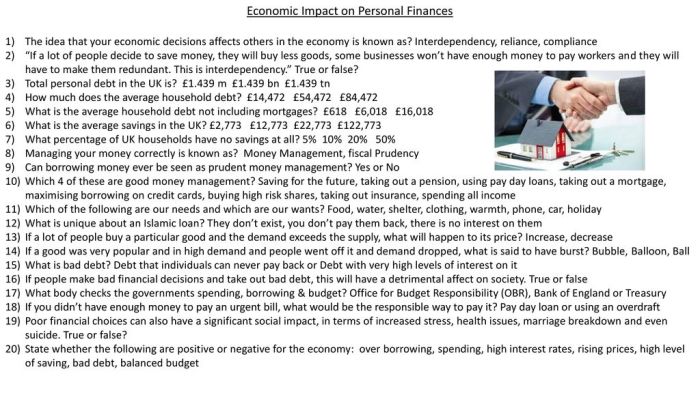Achieving financial freedom and security in a modern economy isn’t just about accumulating wealth; it’s about building a resilient financial life capable of weathering economic storms and supporting your dreams. This journey involves understanding your personal finances, managing debt effectively, and strategically investing for the future. It’s about creating a sustainable financial lifestyle that aligns with your values and goals, allowing you to live comfortably and confidently, regardless of external economic fluctuations.
This guide provides a comprehensive framework for navigating the complexities of modern finance, offering practical strategies and actionable steps to help you build a secure financial future. From budgeting and debt management to investing and retirement planning, we’ll explore key concepts and provide tools to empower you to take control of your financial well-being.
Defining Financial Freedom and Security
Financial freedom and security are often used interchangeably, but they represent distinct yet interconnected concepts crucial for navigating the complexities of the modern economy. Understanding their nuances is key to building a solid financial foundation and achieving long-term well-being.Financial freedom and security, while related, are not identical. Financial security focuses on mitigating risk and ensuring a safety net, while financial freedom emphasizes the ability to live life on your own terms, free from the constraints of needing to work for money.
Both are essential for a fulfilling life, and the path to achieving one often contributes to the other.
Core Components of Financial Freedom and Security
Financial security involves establishing a strong foundation of stability. This includes having enough savings to cover unexpected expenses (emergency fund), adequate insurance protection against various risks (health, life, property), and a manageable level of debt. It’s about minimizing vulnerability to financial shocks and ensuring basic needs are consistently met. Financial freedom, on the other hand, extends beyond mere security.
It signifies having sufficient passive income to cover living expenses, allowing for greater control over one’s time and choices. This often involves strategic investments, diversified income streams, and a proactive approach to wealth creation. A crucial component is achieving a high enough net worth to support your lifestyle without the need for active employment income.
Differences Between Financial Freedom and Financial Security
Financial security is primarily defensive; it’s about protecting against financial hardship. Financial freedom is more offensive; it’s about actively building wealth and achieving a level of independence where money isn’t a primary constraint. You can be financially secure without being financially free (e.g., someone with a stable job and modest savings), but it’s difficult to achieve true financial freedom without a solid foundation of financial security.
The transition from security to freedom often involves calculated risk-taking and strategic investment.
Traditional and Modern Approaches to Achieving Financial Freedom
Traditional approaches often emphasized frugality, saving diligently, and investing conservatively. This involved strategies like prioritizing debt repayment, building a robust emergency fund, and gradually accumulating assets through long-term investments like real estate or bonds. Modern approaches leverage technology and diversified investment opportunities. They incorporate elements of passive income generation, such as online businesses, rental properties, and dividend-paying stocks, along with more active investing strategies like day trading or cryptocurrency.
The modern approach also emphasizes financial literacy and continuous learning to adapt to the ever-evolving financial landscape.
Financial Goals and Timelines
The following table illustrates various financial goals and their typical timelines. These are estimates and may vary based on individual circumstances and market conditions.
| Financial Goal | Timeline (Years) | Example | Considerations |
|---|---|---|---|
| Emergency Fund (3-6 months expenses) | 0-1 | Saving $10,000 for unexpected job loss | Prioritize high-yield savings accounts |
| Debt Elimination (Credit Cards, Loans) | 1-5 | Paying off $20,000 in student loans | Snowball or avalanche method |
| Down Payment on a Home | 3-7 | Saving $50,000 for a down payment | Factor in mortgage rates and closing costs |
| Retirement Savings | 20-40+ | Accumulating $1 million for retirement | Consider 401(k)s, IRAs, and other retirement plans |
Assessing Personal Finances
Understanding your current financial situation is the cornerstone of achieving financial freedom. A clear picture of your income, expenses, and net worth allows you to make informed decisions about saving, investing, and managing debt. This section Artikels practical steps to assess your personal finances and build a solid foundation for your financial future.
Creating a Personal Budget
A personal budget is a plan for how you will spend your money each month. Creating one involves carefully tracking your income and expenses to determine where your money goes and identify areas for potential savings. A well-structured budget helps you prioritize your financial goals and ensures you’re spending within your means.
- Calculate your net income: This is your income after taxes and other deductions. Use your pay stubs or tax returns as references.
- Track your expenses: For a month, record every expense, no matter how small. Use a spreadsheet, budgeting app, or even a notebook. Categorize your expenses (e.g., housing, transportation, food, entertainment).
- Compare income and expenses: Subtract your total expenses from your net income. A positive result indicates you’re saving money; a negative result means you’re spending more than you earn.
- Allocate funds: Based on your income and expenses, allocate funds to different categories. Prioritize essential expenses (housing, food, utilities) and then allocate funds to savings, debt repayment, and discretionary spending.
- Review and adjust regularly: Your budget isn’t set in stone. Review it monthly to ensure it aligns with your financial goals and adjust as needed.
Tracking Income and Expenses
Effectively tracking income and expenses is crucial for understanding your spending habits and making informed financial decisions. Several methods can help you achieve this.
- Spreadsheet Software: Programs like Microsoft Excel or Google Sheets allow for detailed tracking and analysis of your finances. You can create custom categories and formulas to calculate your net income and spending patterns.
- Budgeting Apps: Numerous mobile apps (e.g., Mint, YNAB, Personal Capital) automatically categorize transactions from linked bank accounts and credit cards, providing a clear overview of your spending habits.
- Manual Tracking: Using a notebook or journal to manually record your income and expenses provides a simple and effective method, especially for those who prefer a hands-on approach. However, it requires more diligence and may be less efficient for analyzing large datasets.
Identifying and Eliminating Unnecessary Spending
Once you have a clear picture of your spending habits, you can identify areas where you can cut back. This often involves identifying discretionary spending – expenses that are not essential for your basic needs.
Analyze your expense categories. Look for recurring subscriptions you no longer use, eating out habits that could be replaced with home-cooked meals, or impulse purchases that add up over time. Consider using the 50/30/20 rule as a guideline: 50% of your after-tax income for needs, 30% for wants, and 20% for savings and debt repayment. This rule can help you prioritize and control your spending.
Building an Emergency Fund
An emergency fund is a crucial safety net that protects you from unexpected financial setbacks, such as job loss, medical emergencies, or car repairs. Having 3-6 months’ worth of living expenses saved can provide significant peace of mind.
Several saving approaches can help you build an emergency fund:
- Automatic Transfers: Set up automatic transfers from your checking account to your savings account each month. Even small amounts add up over time.
- “Pay Yourself First”: Treat savings as a non-negotiable expense. Allocate a specific amount to savings before paying other bills.
- Savings Challenges: Participate in savings challenges, such as the 52-week challenge (saving $1 the first week, $2 the second, and so on), to make saving more engaging and trackable.
Managing Debt and Credit
Achieving financial freedom often hinges on effectively managing debt and credit. High-interest debt can significantly hinder progress towards financial security, consuming a large portion of your income and preventing you from saving and investing. Conversely, responsible credit management can build a strong financial foundation, opening doors to better loan terms and financial opportunities.
The Impact of High-Interest Debt
High-interest debt, such as credit card debt or payday loans, acts as a significant drain on personal finances. The high interest rates compound quickly, meaning you pay significantly more than the initial amount borrowed. This can create a cycle of debt, making it difficult to save, invest, or even meet basic living expenses. For example, a $5,000 credit card balance with a 20% interest rate can take years to pay off, even with consistent monthly payments, and result in thousands of dollars in additional interest charges.
This dramatically reduces the resources available for achieving long-term financial goals.
Debt Management Strategies
Several strategies can help manage and eliminate high-interest debt. Debt consolidation involves combining multiple debts into a single loan, often with a lower interest rate. This simplifies payments and can potentially save money on interest. The snowball method prioritizes paying off the smallest debts first for motivational purposes, building momentum to tackle larger debts. The avalanche method focuses on paying off the highest-interest debts first to minimize overall interest paid, leading to faster debt reduction.
Both methods require discipline and consistent payments.
Factors Influencing Credit Scores and Improvement Tips
Credit scores are numerical representations of your creditworthiness, significantly impacting your ability to secure loans, rent an apartment, or even get a job. Key factors influencing credit scores include payment history (the most significant factor), amounts owed, length of credit history, new credit, and credit mix (variety of credit accounts). Improving your credit score involves paying bills on time, keeping credit utilization low (the percentage of available credit used), maintaining a long credit history, avoiding opening many new accounts simultaneously, and maintaining a healthy mix of credit types (e.g., credit cards and installment loans).
Comparison of Credit Cards
Choosing the right credit card can significantly impact your financial well-being. Different cards offer varying benefits, such as rewards programs (cash back, points, miles), interest rates, annual fees, and perks like travel insurance or purchase protection. It’s crucial to compare these factors to find a card that aligns with your spending habits and financial goals.
| Credit Card Type | Benefits | Considerations |
|---|---|---|
| Cash Back | Earning cash back on purchases | Percentage of cash back varies; some have annual fees |
| Travel Rewards | Earning points or miles redeemable for travel | Redemption value can fluctuate; often higher annual fees |
| Low Interest | Lower interest rates on balances | May have stricter eligibility requirements; often limited rewards |
| Student Credit Cards | Designed for students with limited credit history | Lower credit limits; may have higher interest rates |
| Secured Credit Cards | Requires a security deposit; helps build credit | Lower credit limits; may have annual fees |
Investing for the Future
Investing wisely is crucial for achieving long-term financial freedom and security. It allows your money to grow over time, outpacing inflation and providing a foundation for future goals, such as retirement, education, or buying a home. Understanding different investment options and strategies is key to building a portfolio that aligns with your risk tolerance and financial objectives.Investing involves placing your money into assets with the expectation of generating a return.
This return can come in the form of dividends, interest, or capital appreciation (the increase in the asset’s value). However, it’s important to remember that all investments carry some level of risk, meaning you could lose some or all of your invested capital. The level of risk generally correlates with the potential for return – higher potential returns often come with higher risk.
Diverse Investment Options
Choosing the right investments depends on your individual circumstances, risk tolerance, and time horizon. A diversified portfolio, which spreads your investments across different asset classes, is generally recommended to mitigate risk.
- Low-Risk Investments: Savings accounts, certificates of deposit (CDs), and government bonds offer low returns but are generally considered very safe. These are suitable for individuals with a low risk tolerance or those saving for short-term goals.
- Moderate-Risk Investments: Index funds and exchange-traded funds (ETFs) offer diversification and relatively low expense ratios. They track a specific market index, such as the S&P 500, providing exposure to a broad range of companies. These are suitable for long-term investors with a moderate risk tolerance.
- High-Risk Investments: Individual stocks, options, and futures contracts offer the potential for high returns but also carry significant risk. These are generally suitable for experienced investors with a high risk tolerance and a longer time horizon. Real estate is another example of a high-risk investment, offering potential for substantial returns, but also involving significant upfront capital and ongoing management costs.
Investment Strategies: Index Funds, ETFs, and Individual Stocks
Index funds and ETFs offer a simple and cost-effective way to diversify your investments. They provide exposure to a large number of companies, reducing the risk associated with investing in individual stocks. Individual stocks, on the other hand, offer the potential for higher returns but also carry greater risk. Thorough research and understanding of the company’s financial health are crucial before investing in individual stocks.Index funds and ETFs typically have lower expense ratios than actively managed funds, meaning more of your investment earnings go back to you.
Individual stocks can be more volatile and require more time and research to select. The best strategy depends on your risk tolerance, investment goals, and available time for research and monitoring.
Calculating Investment Returns and Compound Interest
Understanding how to calculate investment returns is crucial for tracking your progress and making informed decisions. The simplest way to calculate the return is to subtract the initial investment from the final value, and then divide the result by the initial investment. This gives you the total return. To express this as a percentage, multiply by 100.
Return = (Final Value – Initial Investment) / Initial Investment – 100%
Achieving financial freedom and security in today’s economy requires smart strategies. One effective approach involves building multiple income streams, and a key element of that is developing passive income. Check out this guide on Securing a luxury lifestyle through passive income streams to learn more. Ultimately, diversifying your income sources is crucial for long-term financial stability and achieving your goals.
Compound interest is the interest earned on both the principal amount and accumulated interest. It’s a powerful tool that can significantly accelerate your investment growth over time. The longer your money is invested and the higher the interest rate, the greater the impact of compounding.
Achieving financial freedom and security in today’s world requires careful planning and smart investing. A key component is securing a comfortable retirement, and understanding the best strategies is crucial. Check out this guide on Best ways to invest for a luxury lifestyle retirement to learn how to build a solid financial foundation for your future. Ultimately, proactive financial management is the path to long-term security and peace of mind.
Future Value = Present Value
(1 + Interest Rate)^Number of Years
Opening a Brokerage Account and Starting to Invest
Opening a brokerage account is a straightforward process. Here’s a step-by-step guide:
- Choose a Brokerage: Research different brokerages, comparing fees, investment options, and research tools. Consider factors like account minimums, trading fees, and available research resources.
- Complete the Application: You’ll need to provide personal information, such as your name, address, Social Security number, and employment information. Be prepared to answer questions about your investment experience and risk tolerance.
- Fund Your Account: Transfer funds from your bank account to your brokerage account. This can typically be done electronically.
- Start Investing: Once your account is funded, you can begin researching and purchasing investments. Remember to start with a small amount and diversify your portfolio.
Planning for Retirement: Achieving Financial Freedom And Security In A Modern Economy
Retirement planning is crucial for securing your financial future and ensuring a comfortable lifestyle after your working years. Failing to adequately plan can lead to significant financial hardship in later life. This section explores various strategies to help you build a solid retirement nest egg and navigate the financial realities of retirement.
Retirement Planning Strategies, Achieving financial freedom and security in a modern economy
Several vehicles exist to help you save for retirement. Each offers different benefits and drawbacks depending on your individual circumstances and risk tolerance. Understanding these options is key to developing a comprehensive retirement plan.
- 401(k)s: Employer-sponsored retirement plans that often include matching contributions. These contributions are typically tax-deferred, meaning you don’t pay taxes on the money until you withdraw it in retirement. The contribution limits are set annually by the IRS.
- IRAs (Individual Retirement Accounts): These are self-directed retirement accounts that offer tax advantages. Traditional IRAs offer tax-deductible contributions, while Roth IRAs offer tax-free withdrawals in retirement. Contribution limits are also set annually by the IRS.
- Pensions: Defined benefit plans, less common now than in the past, provide a guaranteed monthly income in retirement based on your salary and years of service. These plans are typically offered by employers, and the amount of the pension is predetermined by a formula.
Healthcare Costs in Retirement
Healthcare expenses are a significant and often underestimated factor in retirement planning. Medical costs can rise substantially as you age, potentially impacting your retirement budget significantly. It’s crucial to consider these expenses when planning for retirement. Medicare, the government health insurance program for those 65 and older, helps cover some costs, but supplemental insurance or savings are often necessary to cover gaps in coverage and out-of-pocket expenses.
Long-term care insurance is another important consideration, as the cost of nursing homes or assisted living facilities can be exceptionally high.
Factors Influencing Retirement Income Needs and Calculation Methods
Several factors influence how much income you’ll need in retirement. These include your desired lifestyle, current living expenses, inflation, life expectancy, and healthcare costs. Several methods exist to estimate retirement income needs. One common approach is the 80% rule, which suggests you’ll need about 80% of your pre-retirement income to maintain your lifestyle. However, this is a general guideline, and individual needs may vary significantly.
More sophisticated methods involve projecting future expenses, adjusting for inflation, and considering potential income sources like Social Security and pensions. Financial advisors can assist with more detailed calculations. For example, a couple retiring with a pre-retirement income of $100,000 might aim for a retirement income of $80,000 annually, but this needs to be adjusted for inflation and potential healthcare costs.
Achieving financial freedom and security in today’s economy requires careful planning and budgeting. It’s easy to get caught up in the allure of a lavish lifestyle, but remember to factor in the often-overlooked expenses; check out this article on Hidden costs of maintaining a luxury lifestyle to avoid costly surprises. Ultimately, true financial security comes from smart choices, not just high earnings.
Sample Retirement Budget
A sample retirement budget helps illustrate the importance of planning. This is a simplified example and should be adjusted to reflect your individual circumstances.
| Income Source | Estimated Monthly Income |
|---|---|
| Social Security | $2,000 |
| Pension | $1,000 |
| 401(k)/IRA Withdrawals | $2,500 |
| Total Monthly Income | $5,500 |
| Expense Category | Estimated Monthly Expense |
|---|---|
| Housing | $1,500 |
| Food | $500 |
| Transportation | $300 |
| Healthcare | $1,000 |
| Utilities | $200 |
| Entertainment/Travel | $500 |
| Total Monthly Expenses | $4,000 |
Note: This is a simplified example. Actual expenses and income will vary depending on individual circumstances and location. It is crucial to create a personalized budget that reflects your specific needs and financial situation.
Protecting Assets and Managing Risk
Building financial freedom and security isn’t just about accumulating wealth; it’s about safeguarding what you’ve worked so hard to achieve. Unexpected events can significantly impact your financial stability, making risk management and asset protection crucial components of a robust financial plan. This section explores strategies to protect your assets and mitigate potential financial setbacks.Protecting your assets and mitigating risks requires a proactive approach involving various strategies, from securing appropriate insurance coverage to carefully planning for the future.
A comprehensive strategy ensures your financial well-being even in the face of unforeseen circumstances.
The Importance of Insurance in Protecting Financial Assets
Insurance acts as a safety net, protecting your financial assets from the potentially devastating costs associated with unexpected events. By transferring the risk of financial loss to an insurance company, you can safeguard yourself and your family from unforeseen expenses that could otherwise wipe out your savings or lead to significant debt. The cost of insurance is a small price to pay compared to the potential financial ruin caused by an uninsured event.
Different types of insurance address various risks, ensuring comprehensive protection.
Types of Insurance Coverage
Several types of insurance are vital for comprehensive financial protection. Health insurance covers medical expenses, preventing crippling debt from illness or injury. Life insurance provides a financial safety net for dependents in the event of the policyholder’s death, ensuring their financial security. Disability insurance replaces income lost due to illness or injury, preventing financial hardship during periods of incapacitation.
Home insurance protects your home and its contents from damage caused by fire, theft, or natural disasters. Auto insurance covers damage or injury resulting from car accidents. Consider also umbrella insurance, which provides additional liability coverage beyond what’s offered by your other policies. The specific types and amounts of insurance you need will depend on your individual circumstances and risk tolerance.
Strategies for Mitigating Financial Risks
Beyond insurance, several strategies can help mitigate financial risks. Diversification of investments spreads risk across different asset classes, reducing the impact of losses in any single investment. Emergency funds provide a cushion to cover unexpected expenses, preventing the need to borrow money at high interest rates. Budgeting and financial planning enable you to anticipate and prepare for potential expenses, minimizing the impact of unforeseen events.
Regularly reviewing and adjusting your financial plan allows you to adapt to changing circumstances and maintain financial stability. For example, during periods of economic uncertainty, you might increase your emergency fund or adjust your investment strategy to be more conservative.
Creating a Comprehensive Estate Plan
A comprehensive estate plan ensures your assets are distributed according to your wishes and protects your loved ones from potential legal disputes or financial burdens after your death. This typically involves creating a will, which specifies how your assets will be distributed, and potentially establishing a trust, which can provide for the management and distribution of assets according to your instructions, even after your incapacity or death.
A will ensures that your assets go to your chosen beneficiaries, while a trust can offer more sophisticated control over asset distribution and management, potentially minimizing estate taxes and protecting assets for minor children. Consulting with an estate planning attorney is crucial to create a plan that meets your specific needs and circumstances. Failing to plan can lead to unintended consequences, causing significant hardship for your family and complicating the distribution of your assets.
Adapting to Economic Changes
Navigating the modern economy requires flexibility and adaptability. Economic conditions are rarely static; inflation, recessions, and unexpected events can significantly impact personal finances. Understanding these fluctuations and proactively adjusting your financial strategy is crucial for long-term financial security.Economic downturns and periods of high inflation present unique challenges to personal finances. Inflation erodes the purchasing power of money, meaning that the same amount of money buys fewer goods and services over time.
Economic downturns, often characterized by high unemployment and reduced economic activity, can lead to job losses, decreased income, and a decline in asset values. These factors can severely strain household budgets and jeopardize long-term financial goals.
Inflation’s Impact and Mitigation Strategies
Inflation directly impacts the real value of savings and investments. For example, if inflation is 5% and your savings account earns 3%, your real return is actually negative 2%. To mitigate this, consider diversifying investments into assets that historically outperform inflation, such as stocks and real estate. Regularly re-evaluating your budget and adjusting spending habits based on rising prices is also essential.
Prioritizing needs over wants and seeking out cost-effective alternatives can significantly reduce the impact of inflation on your finances. For instance, switching to a less expensive grocery store or negotiating lower utility bills can help to free up resources.
Building financial freedom and security in today’s world requires smart planning and consistent effort. It’s not just about accumulating wealth, but also about defining what true wealth means to you; this often involves a deeper look at your values, as explored in this insightful article on Achieving a fulfilling luxury lifestyle beyond material possessions. Ultimately, achieving financial security allows you to pursue a life rich in experiences and personal fulfillment, far beyond the limitations of mere material possessions.
Responding to Economic Downturns
Economic downturns require a proactive and cautious approach to personal finances. Building an emergency fund that can cover several months of living expenses is crucial. This fund serves as a buffer during job loss or unexpected expenses. Reviewing and potentially reducing discretionary spending is also advisable. Consider postponing large purchases and focusing on essential expenses until economic conditions improve.
If facing job loss, actively seek new employment opportunities and explore options such as unemployment benefits or temporary work. Negotiating with creditors for payment extensions or exploring debt consolidation options can help manage financial stress during tough times.
Utilizing Financial Education Resources
Numerous resources are available to help individuals navigate economic uncertainty. Government agencies like the Consumer Financial Protection Bureau (CFPB) offer valuable information on managing debt, budgeting, and consumer rights. Non-profit organizations, such as the National Foundation for Credit Counseling (NFCC), provide free or low-cost financial counseling services. Many reputable financial websites and educational platforms offer courses and resources on various financial topics, including investing, retirement planning, and debt management.
Taking advantage of these resources can empower individuals to make informed decisions and build financial resilience.
Examples of Successful Navigation of Economic Challenges
Many individuals have successfully navigated economic challenges by implementing sound financial strategies. For instance, some individuals have successfully downsized their homes or changed careers during economic downturns to reduce expenses and increase income stability. Others have used periods of economic uncertainty as opportunities to further their education or acquire new skills, improving their long-term job prospects. These examples demonstrate the importance of adaptability, resourcefulness, and a proactive approach to personal finance in the face of economic uncertainty.
Successful navigation often involves a combination of proactive planning, prudent spending, and the utilization of available resources.
Building a Sustainable Financial Lifestyle

Source: slideplayer.com
Achieving financial freedom isn’t a sprint; it’s a marathon requiring consistent effort and mindful choices. Building a sustainable financial lifestyle involves creating habits and strategies that ensure long-term financial well-being, allowing you to enjoy life today without jeopardizing your future. This requires a blend of mindful spending, strategic saving, and smart investing.Mindful spending habits and long-term financial planning are crucial for building a sustainable financial lifestyle.
Impulsive purchases and a lack of planning can quickly derail even the most well-intentioned financial goals. By consciously tracking expenses, setting realistic budgets, and prioritizing long-term investments, you lay a strong foundation for future financial security. This proactive approach allows you to navigate unexpected expenses and economic downturns with greater resilience.
Mindful Spending Habits
Mindful spending involves understanding your spending patterns, identifying areas where you can cut back, and making conscious choices about how you allocate your resources. This isn’t about deprivation; it’s about making informed decisions that align with your financial goals. For instance, tracking expenses using budgeting apps can reveal surprising spending patterns, highlighting areas where savings can be maximized.
Creating a detailed budget, allocating funds for necessities, savings, and discretionary spending, helps to maintain control over your finances. Prioritizing needs over wants and delaying gratification for larger purchases allows for better savings and investment opportunities.
The Benefits of a Frugal Lifestyle
Adopting a frugal lifestyle doesn’t mean sacrificing quality of life. It’s about making smart choices and prioritizing value over extravagance. The benefits are numerous: reduced debt, increased savings, greater financial flexibility, and reduced stress. For example, buying used items instead of new ones, cooking at home more often than eating out, and finding free or low-cost entertainment options can significantly reduce expenses without diminishing enjoyment.
This allows for the redirection of funds towards investments, retirement savings, or other long-term goals, leading to a more secure financial future.
Sustainable Financial Practices for Daily Routines
Incorporating sustainable financial practices into daily routines can significantly impact long-term financial health. These practices are easily integrated into everyday life and require minimal effort. For example, using reusable shopping bags, packing lunches instead of buying takeout, and turning off lights and appliances when not in use, can save money and contribute to environmental sustainability. Regularly reviewing bank statements and credit card bills helps to identify and correct any errors, prevent fraud, and track spending patterns.
Setting up automatic transfers to savings accounts ensures consistent savings without requiring conscious effort.
Resources and Tools for Financial Literacy
Access to reliable information and tools is crucial for promoting financial literacy and responsible financial behavior. Many resources are available to help individuals manage their finances effectively.
- Government websites: Many governments offer free financial literacy resources, including budgeting tools, retirement planning calculators, and educational materials.
- Non-profit organizations: Numerous non-profit organizations provide financial education programs and resources to individuals and families.
- Financial literacy websites and apps: Several websites and apps offer tools and resources for budgeting, investing, and debt management.
- Books and courses: Many books and online courses are available on various aspects of personal finance.
- Financial advisors: Consulting a financial advisor can provide personalized guidance and support in achieving financial goals.
Final Summary
Building financial freedom and security is a marathon, not a sprint. It requires consistent effort, discipline, and a long-term perspective. By understanding your finances, managing debt wisely, investing strategically, and adapting to economic changes, you can create a solid foundation for a secure and fulfilling future. Remember, it’s a journey of continuous learning and refinement, so embrace the process, celebrate your progress, and never stop striving for financial well-being.
Question Bank
What’s the difference between saving and investing?
Saving is setting aside money for short-term goals in low-risk accounts like savings accounts or money market funds. Investing involves putting money into assets like stocks or bonds with the expectation of higher returns over the long term, but with higher risk.
How much should I contribute to retirement?
The ideal contribution amount depends on your income, age, and retirement goals. A good starting point is to aim for at least what your employer matches in a 401(k), and then gradually increase contributions as your income allows.
What are some good resources for learning more about personal finance?
Many reputable websites and organizations offer free financial education resources. Look into sites like the Consumer Financial Protection Bureau (CFPB), the National Endowment for Financial Education (NEFE), and reputable financial literacy websites.
How can I protect myself from identity theft?
Monitor your credit reports regularly, use strong passwords, be cautious about phishing scams, and shred sensitive documents. Consider a credit freeze to prevent unauthorized credit applications.
What should I do if I lose my job?
First, tap into your emergency fund. Then, explore unemployment benefits, update your resume, network with contacts, and consider taking on temporary work while searching for a new job.




